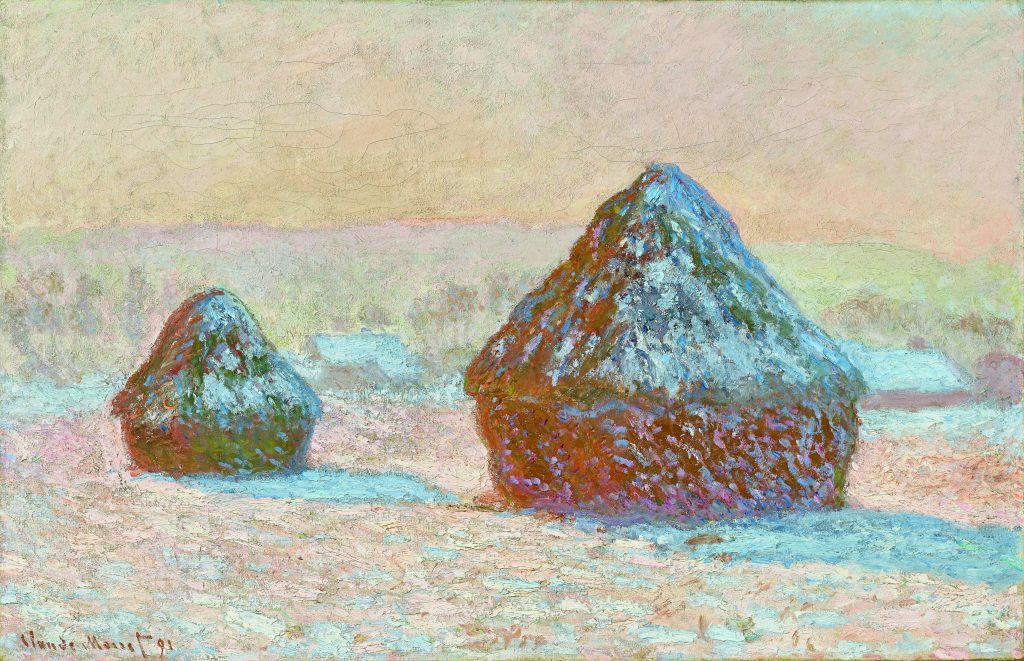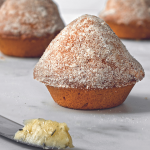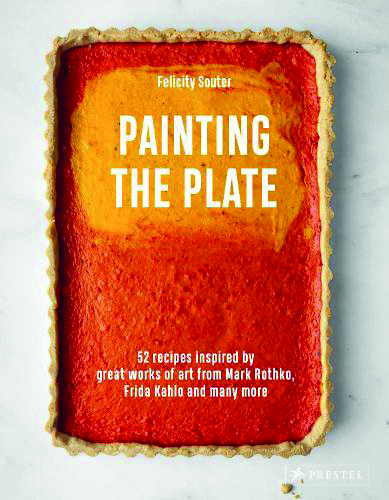Looking uncannily similar to Monet’s haystacks, the texture of these muffins is luckily nothing like straw! Similar to scones, they’re perfect for lathering with the accompanying flavoured butter at breakfast or as part of an afternoon tea. Serve them outside en plein air to really embrace Monet’s way of life.
Jump to RecipeClaude Monet ate lunch at 11.30am sharp – no sooner, no later. He lived by a rigid timetable, which he also expected everyone around him to follow, including his guests. If anything wasn’t up to his standard, he’d go into a rage; a common occurrence, particularly if his painting wasn’t going well. In 1908, he famously destroyed 15 water lily canvases he’d been working on for three years, right before they were set to be exhibited. He constantly strived for perfection in his art and in his daily life and even in his food.
Monet ate lunch early because he got up at dawn. He’d look at the mountains to check the weather conditions, bathe, and sit down for breakfast with his stepdaughter
Blanche. She was also an artist and often worked as Monet’s assistant, setting up easels and canvases wherever he chose to work that day. They ate eggs, bacon, sausages, cheese, omelette and toast with homemade preserves – customs Monet had picked up during his travels around Europe – before heading into the garden or to his
boat studio, to paint until lunch.
Guests were welcomed for lunch rather than dinner as Monet didn’t enjoy painting in the harsh midday light and went to bed early to maintain his routine. Artists Pissarro, Renoir, Sisley and Cézanne were regular visitors, while collectors, such as the Kuroki family, were particularly special guests. The meal was served either formally in the bright-yellow dining room on Limoges porcelain of the artist’s own design, or informally as a picnic out in the garden if the weather allowed. A picnic was particularly welcome if Monet had successfully foraged cèpes, his favourite mushroom.
The artist collected recipes throughout his life, carefully recording meals of note during his travels, but his recipe for cèpes is argued to be the only one in his collection that he could really claim to be his own.
He may have dictated what was on the menu, but he never did the cooking: “I have two skills only,” Monet said, “horticulture and painting”.
At the artist’s precise instructions, dinner was also served early, always starting
with soup, then an egg or cheese soufflé, followed by a poultry or gratin main with a salad. Monet was even particular about his salad and would insist on making his own dressing at the table, which contained so much black pepper no-one else could stomach it. The salad leaves were grown in the gardens, as were many of the ingredients that reached the dinner table.
His famous home Maison du Pressoir, now known as Maison du Monet, had large decorative gardens by the house as well as a walled kitchen garden on the other side of the village, which Monet and his staff meticulously attended to.

Just as they affected the gardens, the seasons also influenced Monet’s work; he captured the changes in his countless paintings of water lilies and year-long series of haystack studies. The seasons also influenced what his family ate throughout the year. Many of his lesser-known works reflect the changing seasons within his home. Still lifes of perfectly ripe melons and sunny picnic scenes in the glorious gardens give us a glimpse of the dreamy summer months, while paintings of game from his family’s hunting expeditions show us what the family enjoyed during the winter.
With his life and practice so intertwined, Monet mastered the art of living, curating his surroundings to form an enviably picturesque life. As long as it was done his way, of course.
French breakfast muffins with honey and thyme butter
Ingredients
For the honey and thyme butter
- 2 tsp fresh thyme leaves
- 80 g unsalted butter softened
- 4 tsp runny honey
- 1 tsp fine salt
For the muffins
- 100 g unsalted butter melted
- 280 g plain flour
- 2 tsp baking powder
- 125 g caster sugar
- 1 tsp fine salt
- 1/2 tsp ground nutmeg
- 150 ml full fat milk
- 2 eggs
- 1 tsp vanilla bean paste
For the topping
- 50 g caster sugar
- 1 tsp ground cinnamon
- 70 g unsalted butter melted
Instructions
- For the honey and thyme butter, use the back of a wooden spoon to crush the thyme leaves and release their aroma, then finely chop them. In a medium-sized bowl, use a wooden spoon to beat the butter until light and fluffy. Add the thymeleaves, honey and salt, and mix to combine. Tip onto a piece of parchment paper and form the butter into a log or rectangle. Wrap the parchment paper around the butter and refrigerate. Remove from the refrigerator 10 minutes before ready to serve to allow it to soften slightly.
- Preheat the oven to 180°C/160°C fan. Brush a 12-cup muffin tin with 1 tsp of the melted butter.
- For the muffins, sift the plain flour and baking powder into a large bowl, then stir in the caster sugar, salt and nutmeg. Make a well in the centre, then add the milk, eggs, vanilla bean paste and the remaining melted butter, and mix until combined.
- Divide the batter evenly among the muffin cups – they should be quite full. Bake for 25 minutes, or until the tops are golden and a skewer inserted in the middle of a muffin comes out clean. Let cool for five minutes.
- For the topping, in a small bowl, mix together the caster sugar and cinnamon. Pour the melted butter into a separate small bowl.
- Remove the muffins from the tin and dip the tops into the melted butter one at a time. Shake off any excess, then immediately roll the muffin tops in the cinnamon sugar.
- Serve the muffins warm with the honey and thyme butter on the side.
Recipe extracted from Painting The Plate by Felicity Souter. Published by Prestel, RRP £29.99









